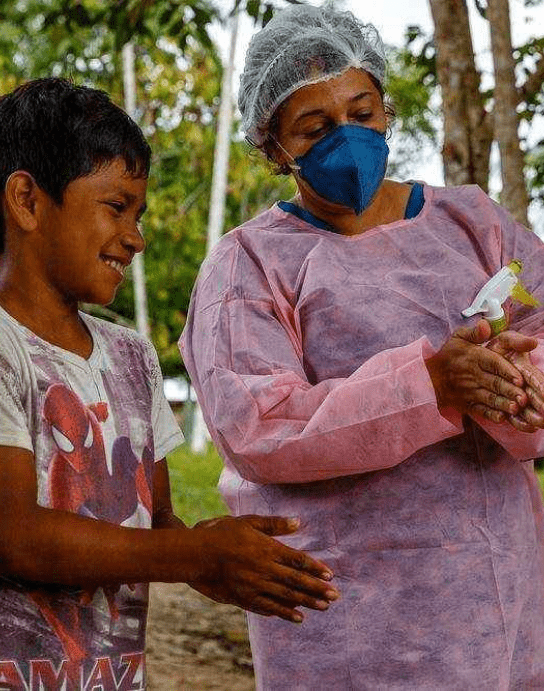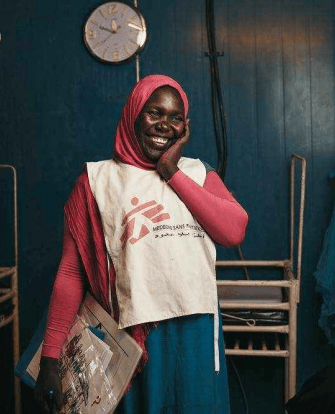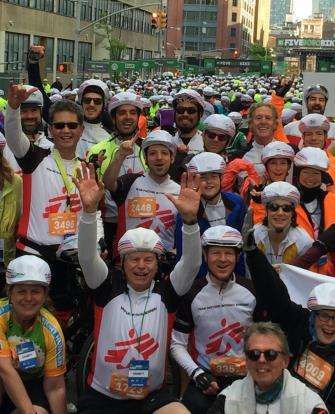A resurgence of violence in eastern Democratic Republic of Congo (DRC) is worsening the already-dire humanitarian emergency in the country, forcing millions to flee their homes to overcrowded camps where access to basic needs is severely limited as needs skyrocket.
Doctors Without Borders/Médecins Sans Frontières (MSF) teams working in DRC are witnessing how this latest escalation of violence is impacting people’s lives and compounding the humanitarian crisis, particularly in camps where displaced people are sheltering. As the conflict continues to unfold, here’s what to know about what’s happening in eastern DRC and how to help.

What's happening in DR Congo?
The violence we're seeing now in eastern DRC is part of a protracted conflict that has afflicted the region for decades. Its lush, fertile land is rich with natural resources like gold, copper, lithium, and oil, which armed groups have been fighting to access and control as millions of civilians are caught in between, facing attacks, repeated displacement, and increasingly dire conditions in camps.
At a glance: DR Congo
- DRC is the second-largest country in Africa, about the size of Western Europe
- Today, 7.2 million people are displaced in DRC—a record for the country— and the vast majority are in the eastern provinces.
- According to the UN, DRC is one of the five conflict zones with the highest numbers of serious violations against children, alongside Palestine, Somalia, Ukraine, and Syria.
- 75 percent of the population live on less than $2.15 per day, making DRC one of the poorest countries in the world.
- Childhood vaccine coverage is the lowest in 30 years, according to the World Health Organization.
- An estimated 6 million people have been killed by conflict in eastern DRC since 1996.
Resurgence of the M23 conflict
The Congolese army and its allies are fighting the March 23 Movement, known as M23, which has been progressively taking over territory eastern DRC since 2022. The fighting began to intensify in January 2024, causing mass casualties and displacement. North Kivu, South Kivu, and Ituri provinces are the most affected. The escalation has impacted people’s access to health care, food, and other basic needs, triggering mass waves of displacement and raising the risk of disease outbreaks.
Repeated waves of mass displacement
Over 5 million people are displaced across Ituri, North Kivu, and South Kivu, including 2 million who have fled in just the last two years. As people continue to flee the fighting, displacement camps around Goma, the capital of North Kivu, are growing more crowded and living conditions are deteriorating further, with severely limited access to basic needs such as proper shelter, food, water, sanitation facilities, and health care. Some new arrivals don’t even have plastic sheeting to cover their makeshift shelters. Displaced people living in these conditions are at increased risk of falling ill.
In some areas, such as Masisi territory, displaced people are sheltering wherever they can, including schools, churches, and sheds.
Inadequate humanitarian response
Since day one, the international humanitarian response has been inadequate and far too slow to meet the severity of the situation and the fast-growing needs in DRC, with underfunding, ineffective coordination, and lack of emergency preparedness in areas close to the front lines. In some areas, MSF is alone in addressing medical and humanitarian needs, which far outweigh our capacity to respond.
How MSF is responding to health risks facing Congolese people
People in DRC have faced acute health needs for years—such as Ebola and HIV outbreaks—but the conflict has exacerbated the health threats people face in the east, including by causing direct harm to civilians through war-related injuries, increasing the risk of disease outbreaks, and making health care more difficult to access.
By the numbers: MSF response in DR Congo
- Treatment for over 20,000 cholera patients in North and South Kivu’s Minova health zone and 126,000 vaccinations.
- Care for more than 22,000 survivors of sexual violence, including nearly 17,000 emergency interventions.
- 1.5 million medical consultations, including more than 557,000 during emergency responses.
- Treatment for over 30,000 patients with measles, one-third of whom were in displacement sites.
- Treatment for nearly 20,000 children with acute malnutrition.
MSF has worked in DRC for 40 years, providing medical and mental health care, water and sanitation support, humanitarian relief, and training and other capacity-building activities to strengthen local health response. We respond to disease outbreaks including measles, cholera, and mpox, treat children with malnutrition at our inpatient and outpatient therapeutic feeding centers, and have emergency teams on standby throughout DRC, ready to respond to unanticipated disasters.

DR Congo 2023 © Michel Lunanga/MSF
Measles
Measles cases are again surging this year in DRC, which has faced persistent epidemics for years and high fatality rates due to inadequate routine vaccinations and supplementary immunization. In 2023, over 300,000 measles cases were recorded, resulting in nearly 6,000 deaths. Children are particularly vulnerable; from 2018 to 2020, 8,000 children died from measles during the largest outbreak ever documented in DRC. Despite the persistent threat of measles, vaccine coverage remains insufficient in the country.

DR Congo 2023 © Michel Lunanga/MSF
Cholera
Cholera is endemic to eastern DRC, with recurrent outbreaks across all three provinces. The risk is especially high in camps where displaced people live without access to drinking water and nonfunctional or nonexistent latrines, and following floods. MSF has responded to several cholera outbreaks in the region, including in Minova, Rutshuru territory, and in and around Goma, by setting up cholera treatment centers, oral rehydration points, and isolation units, and distributing clean drinking water.

DR Congo 2023 © Alain Duhamel Ntungane/MSF
Mpox
The first case of mpox, formerly known as monkeypox, in a human was identified in DRC in 1970, and the disease continues to affect communities there, particularly in places where the natural environment is conducive to its spread, such as dense woodlands where people rely on hunting and fishing for food.

DR Congo 2022 © Alexis Huguet
Sexual & gender-based violence
MSF teams in DRC have seen alarming rates of sexual violence as reported by our patients, especially in camps around Goma. Most assaults are perpetrated against women searching for food or wood outside the camps, driven to venture out due to lack of access to basic supplies. Our teams treated more than 22,000 survivors of sexual violence in North and South Kivu’s Minova health zone last year, and continue to see high numbers of cases at the facilities where we work throughout the region. This represents only the survivors who sought care from MSF; the true number of survivors is likely far higher due to stigma and barriers to accessing care.

DR Congo 2023 © MSF
War wounds & trauma
As the fighting intensifies near cities, civilians are in increasing jeopardy. MSF teams are treating patients with gunshot wounds and injuries from explosions, including children. In Bunia, MSF set up a center specializing in trauma surgery and post-surgical care at Salama Hospital in June 2023; one-third of the 863 patients treated by the end of the year were direct victims of the violence.

DR Congo 2023 © Laora Vigourt/MSF
Food insecurity & malnutrition
Despite being rich with fertile agricultural land, DRC is one of the most food-insecure countries in the world, with more than 23 million people experiencing food insecurity. Food shortages have led to a significant increase in prices, while checkpoints on roads impede access to farmland, leaving crops abandoned. These factors contribute to rising malnutrition rates in DRC.
MSF teams have seen worrying levels of malnutrition among children in many of our projects in eastern DRC. Last year, monthly admissions of children for malnutrition doubled, with an average of 800 per month.

DR Congo 2024 © MSF
Low vaccination coverage
Vaccination coverage among children under five years old in DRC is currently the lowest in about 30 years, according to the World Health Organization (WHO). Low coverage, along with a shortage of medicines and medical supplies and poorly functioning health structures, has increased the risk of disease outbreaks in DRC for years, but the current escalation of the M23 crisis has worsened the threat by forcing more people into crowded, unsanitary camps as they flee the violence.

DR Congo © Michel Lunanga/MSF
Lack of access to health care
Even before the recent escalation of violence, DRC’s health care infrastructure was fragile with insufficient funding and a lack of resources. The conflict has made health care even more difficult to access, forcing staff and patients to abandon facilities near the fighting and restricting people’s ability to reach care through checkpoints and impassable roads. The facilities that remain functional are overwhelmed and undersupplied, with several patients sharing beds. Some have been attacked.
Pregnant women, particularly those with high-risk pregnancies or complications, are at particular risk, often delaying or foregoing seeking care due to difficulty getting to health facilities. DRC has some of the highest rates of maternal and neonatal deaths in the world.
To strengthen local health care infrastructure and improve the quality of medical care throughout DRC, MSF teams are training local medical staff, improving the quality of biomedical equipment, supporting the referral system, donating medical equipment, and constructing health infrastructure.

DR Congo 2022 © Michel Lunanga/MSF
Logistical & geographic challenges
People living in remote areas of DRC often have to travel dozens of miles through the bush to reach health facilities, delaying care. These remote areas are also difficult for health workers to access during vaccination campaigns. Further, it’s sometimes not possible to transport medical supplies like vaccines by foot, because they require refrigeration.
MSF teams use motorcycles and canoes to reach remote communities, but the gaps in care remain.

DR Congo 2023 © Alexandre Marcou/MSF
Water & sanitation
Extreme weather events linked with climate change and longer rainy seasons increase the risk of diseases in DRC by causing floods and damaging water infrastructure. Cholera and skin infections thrive in settings with a contaminated water supply, while mosquitoes that spread diseases like malaria and dengue, which breed in standing water, proliferate.
To curb the spread of disease in camps, MSF provides clean drinking water and constructs and improves water and sanitation infrastructure, including latrines and showers. Last year MSF built a water pumping and chlorination station on the shores of Lake Kivu that processes up to 2 million liters (more than 500,000 gallons) of water each day and distributed hundreds of thousands of gallons of potable water each day to camps around Goma. We also built a 2-mile pipeline to connect Lushagala camp to a water treatment plant in Bulengo, and installed a platform to distribute up to 200,000 liters (more than 50,000 gallons) of water per day in Rusayo. In response to the Congo River floods early this year, MSF teams installed latrines, showers, and lighting; and distributed tents and drinking water to people affected.

Where we work in DR Congo
Camps for displaced people
MSF teams work in camps where displaced people are sheltering throughout DRC, including the camps around Goma and other areas in the eastern provinces such as Drodro in Ituri province. In addition to operating an MSF clinic, our teams set up health posts, run mobile clinics for basic health care and referrals, construct and improve water and sanitation infrastructure, and provide hygiene kits.
Local communities
Our teams also operate in cities and communities where people are settled, including:
NORTH KIVU
- In the city of Goma, we support two health facilities providing medical care and psychosocial support for children in street situations, and sex workers.
- In Walikale territory, MSF supports pediatrics and maternal care at the general referral hospital, provides partial support for seven health centers, and offers care for survivors of sexual violence at a dedicated clinic.
- In Rutshuru territory, MSF supports the general referral hospital and six health centers providing pediatric care, family planning, and treatment for malnutrition and victims of sexual violence.
- In the Sake area, MSF provides vaccinations, cholera response, and constructs latrines in camps.
- In Kibirizi, Binza, Masisi, and Mweso health zones, we support hospitals and health centers in emergency room care, pediatrics, family planning, nutrition, and care for victims of sexual violence. We provide malnutrition care at therapeutic feeding centers in Masisi and Mweso.
ITURI
- In Bunia, MSF set up a center specializing in trauma surgery and post-surgical care at Salama Hospital and supports Kishinji Health Center, which provides care for both local and displaced people and referrals of severe cases to Minova General Referral Hospital.
- In Drodro and Angumu, Ituri province, MSF supports two Ministry of Health hospitals, 12 health centers, three advanced health posts, and 20 community care sites.10
- MSF teams are rehabilitating the health center at Blukwa'Mbi to transform it into a referral center that can provide specialist medical care. It includes a solar-powered operatic theater.
- In Bambo health zone, MSF supports the emergency room, pediatrics, intensive therapeutic nutritional unit, and treatment for victims of sexual violence at the general referral hospital.
SOUTH KIVU
- In Minova health zone, MSF supports Kishinji Health Center, which provides care for both local and displaced people and referrals of severe cases to Minova General Referral Hospital. We also support three health centers where we treat children for malnutrition and survivors of sexual violence.
How you can help
Not everyone can treat patients in the field. But everyone can do something.
Some humanitarian crises make the headlines—others don’t. Unrestricted support from our donors allows us to mobilize quickly and efficiently to provide lifesaving medical care to the people who need it most, whether those needs are in the spotlight or not. And your donation is 100 percent tax-deductible.




